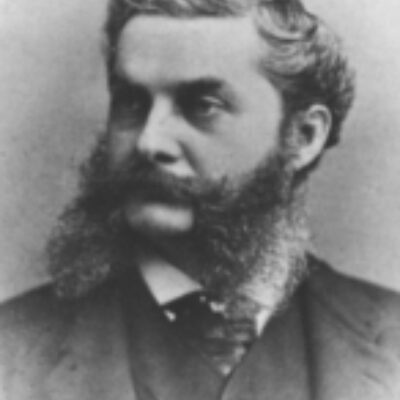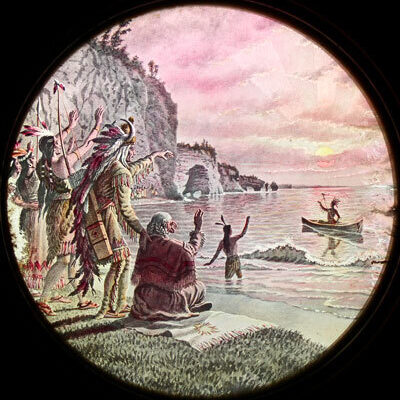The exhibit featured twenty-one dramatic illustrations of Henry Wadsworth Longfellow’s epic poem, The Song of Hiawatha, created by artist Joseph Boggs Beale in the early 1900s. American National Insurance Company generously donated the collection of drawings in 2010. As part of the Library’s ongoing art conservation program, each piece was reframed with acid-free matting to ensure its long-term preservation.

Henry Wadsworth Longfellow
One of the most influential figures in 19th century America, Henry Wadsworth Longfellow was a widely acclaimed celebrity at the time of his death in 1882. Born in Portland, Maine in 1807, Longfellow published his first poem at age thirteen. After graduating from Bowdoin College, he spent several years abroad, continuing his studies and learning new languages. In 1829, Longfellow returned to the United States to teach at Bowdoin. He married Mary Potter in 1831. Tragically, she died just four years later. In 1843, after a seven-year courtship, Longfellow married Frances “Fanny” Appleton, and the couple had six children together.
Longfellow published his first epic poem, Evangeline: A Tale of Acadie, in 1847. The poem was a great success and quickly made Longfellow America’s most famous poet. He retired from teaching in 1854, and the following year published The Song of Hiawatha. Shortly after its publication, the poem became an international sensation.
Inspiration for the poem came from the Finnish epic Kalevala which, like The Song of Hiawatha, was an eclectic mix of folk tales fashioned into a poem. Written in trochaic tetrameter, the poem chronicled the exploits of an Indian hero named Hiawatha. Longfellow studied the traditional legends of the Ojibway Indians and other Native American peoples gathered by ethnographer Henry Rowe Schoolcraft and used these as the basis for his narrative.
The poem begins with the prophesy by Gitche Manito (the Great Spirit) of Hiawatha’s arrival as a peace-maker among the tribes. It goes on to incorporate diverse mythologies and characters into twenty-two chapters. Some include tales of Hiawatha’s childhood adventures, his marriage to the beautiful Minnehaha, the slaying of the evil magician Pearl-Feather, the invention of written language, and the discovery of corn. Throughout the prose are words borrowed from the Ojibway language, such as “Gitche Gumee,” which referred to Lake Superior.
While The Song of Hiawatha paints Native Americans in a sympathetic light, a point that upset some of Longfellow’s contemporaries, its overall message encouraged Native Americans to give up traditional values and beliefs. At the conclusion of the work, Hiawatha’s village is visited by foreign missionaries, and he asks his people to accept their Christian message. Hiawatha launches his canoe westward and departs from his homeland to “The Land of the Hereafter.”

Joseph Boggs Beale
Before the arrival of modern motion pictures in 1896, magic lantern shows were a wildly popular pastime. The magic lantern, an image projector invented in 1659 by Christiaan Huygens, was a tool used for the education and entertainment of many Americans by the mid 19th century. Stories, songs, educational series, Biblical tales, and poems — such as Longfellow’s The Song of Hiawatha — were converted into illustrated slide shows. These shows were accompanied with live narration and sometimes music.
Joseph Boggs Beale was the foremost magic lantern screen artist during the nineteenth century. The eldest child of a prominent Philadelphia family, Joseph Boggs Beale (1841 – 1926) began the study of art and writing at an early age. In 1860, he enrolled in the Pennsylvania Academy of the Arts and eventually became a professor at Philadelphia’s prestigious Central High School. During the Civil War, Beale enlisted in the volunteer reserves and created sketches of battle scenes for publication in illustrated news magazines such as Frank Leslie’s Weekly, Harper’s Weekly, and The Daily Graphic.

In 1868, Beale married Mary Louise Taffart and moved to Chicago to become a book illustrator. He eventually returned to Philadelphia in 1871 and took a job as a commercial artist for the Frank Harris Lithography Company. Beale’s career path changed course when he began working for the firm of Caspar Briggs & Sons to create original designs for glass slides used with magic lantern projectors, predecessors to motion pictures cameras.

Joseph Boggs Beale created more than 2,000 illustrations for magic lantern projectors. The production drawings displayed in the library’s exhibit were never intended to be seen by the public. These black and white images functioned as the first step in the development of color screen images to be used with magic lantern projectors. Original master drawings were photographed, then reduced in size and printed on glass negatives. The glass negatives were used to produce positive images, and these were hand-painted to create the final color images seen in theaters.
The motion picture industry eventually made magic lantern entertainment obsolete, and Beale’s legacy has been mostly forgotten. However, the artistic techniques he employed to create vivid three-dimensional screen images set the stage for future cinematic aesthetics.
An Interactive Experience
In order to enhance the exhibit experience, the Rosenberg Library collaborated with CC Prose, a company dedicated to making classic literature accessible to all people. Visitors to “By the Shore of Gitchee Gumee” can use their smartphones to listen to an audio recording of the poem. You won’t want to miss this unforgettable interactive experience!
This unique exhibition of art and literature was on display through September 2012.